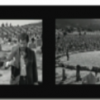Description
The fMRI data provided here have been used to study the visual system under the natural vision paradigm. Specifically, the data have been used to 1) explore the potential confounds of this paradigm (Lu et al., 2016) and 2) investigate the structure of the BOLD signal observed in white matter using natural vision (Marussich et al., 2017).
Thirteen subjects underwent four fMRI sessions with two conditions. Two sessions were obtained in the eyes-closed resting state, and the other two sessions occurred during free-viewing of an identical movie clip The Good, the Bad, and the Ugly, 1966, from 162:54 to 168:33 min. in the film). The visual input was presented using the MATLAB Psychophysics Toolbox, and they were delivered to subjects through a binocular goggle system (NordicNeuroLab, Norway) mounted on the head coil. Each movie-stimulation (task) session began with a blank gray screen presented for 42 s, followed by the movie presented for 5 min and 37 s, and ended with the blank screen again for 30 s. The resting-state sessions had the same duration as the movie-stimulation sessions.
Lu K-H, Hung S., Wen H., Marussich L., Liu Z., "Influences of high-level features, gaze, and scene transitions on the reliability of BOLD responses to natural movie stimuli," PLoS ONE, 11(8): e0161797, 2016.
Marussich, L. Lu K-H, Wen H., Liu Z., "Mapping white-matter functional organization at rest and during naturalistic visual perception," NeuroImage, 146: 1128-1141, 2017.
Cite this work
Researchers should cite this work as follows:
- Lu, K.; Marussich, L. K.; Wen, H.; Hung, S.; Liu, Z. (2017). Repeated Free-Viewing of a Natural Movie Stimulus Using fMRI. Purdue University Research Repository. doi:10.4231/R71V5C4T
Tags
Notes
Whole-brain structural and functional MRI images were acquired using a 3-Tesla Signa HDx MRI system (General Electric Health Care, Milwaukee, USA). Briefly, the fMRI data were acquired using a single-shot, gradient-recalled (GRE) echo- planar imaging (EPI) sequence (38 interleaved axial slices with 3.5mm thickness and 3.5 × 3.5 mm2 in-plane resolution, TR=2000 ms, TE=35 ms, flip angle=78°, field of view=22×22 cm2). T1-weighted anatomical images covering the whole head were acquired with a spoiled gradient recalled acquisition (SPGR) sequence (1×1×1mm3 nominal resolution, TR/TE=5.7/2 ms, flip angle=12°). A 16-channel receive-only phase array coil (NOVA Medical, Wilmington, USA) was used during all acquisitions.
Nifti files may be viewed in an nii viewer such as MRIcron, which is freely available at: http://people.cas.sc.edu/rorden/mricron/install.html.
The dataset can be more easily accessed through the ftp protocol as file 10_4231_R71V5C4T.zip on the PURR's FTP server. For instructions how to access the zip file, see https://purr.purdue.edu/kb/projects/access-datasets-using-ftp-client.
Laboratory of Integrated Brain Imaging
This publication belongs to the Laboratory of Integrated Brain Imaging group.

